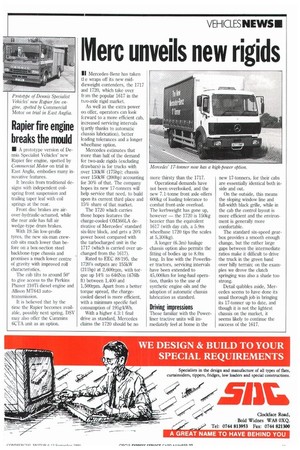Melt un veils new rigids
Page 13

If you've noticed an error in this article please click here to report it so we can fix it.
II Mercedes-Benz has taken ti .e wraps off its new middleweight contenders, the 1717 and 1720, which take over fram the popular 1617 in the two-axle rigid market.
As well as the extra power on offer, operators can look fcrward to a more efficient cab, increased servicing intervals (I artly thanks to automatic chassis lubrication), better loading tolerances and a longer wheelbase option.
Mercedes estimates that more than half of the demand for two-axle rigids (excluding drawbars) is for trucks with over 130kW (175hp); chassis over 150kW (200hp) accounting for 30% of that. The company hopes its new 17-tonners will help service that need, to build upon its current third place and 15% share of that market.
The 1720 which carries those hopes features the charge-cooled 0M366LA derivative of Mercedes' standard six-litre block, and gets a 20% power boost compared with the turbocharged unit in the 1717 (which is carried over unchanged from the 1617).
Rated to EEC 88/195, the 1720's outputs are 155kW (211hp) at 2,600rpm, with torque up 14% to 646Nm (476Ib ft) between 1,400 and 1,500rpm. Apart from a better torque spread, the chargecooled diesel is more efficient, with a minimum specific fuel consumption of 195g/kWh.
With a higher 4.3:1 final drive as standard, Mercedes claims the 1720 should be no more thirsty than the 1717, Operational demands have not been overlooked, and the new 7.1-tonne front axle offers 600kg of loading tolerance to combat front-axle overload. The kerbweight has gone up, however — the 1720 is 150kg heavier than the equivalent 1617 (with day cab, a 5.9m wheelbase 1720 tips the scales at 5,300kg).
A longer (6.3m) haulage chassis option also permits the fitting of bodies up to 8.0m long. In line with the Powerliner tractors, servicing intervals have been extended to 45,000km for long-haul operation, thanks to the use of synthetic engine oils and the adoption of automatic chassis lubrication as standard.
Driving impressions
Those familiar with the Powerliner tractive units will immediately feel at home in the new 17-tonners, for their cabs are essentially identical both inside and out.
On the outside, this means the sloping window line and full-width black grille, while in the cab the control layout is more efficient and the environment is generally more comfortable.
The standard six-speed gearbox provides a smooth enough change, but the rather large gaps between the intermediate ratios make it difficult to drive the truck in the green band over hilly terrain; on the examples we drove the clutch springing was also a shade too strong.
Detail quibbles aside, Mercedes seems to have done its usual thorough job in bringing its 17-tonner up to date, and though it is not the lightest chassis on the market, it seems likely to continue the success of the 1617.




























































































































